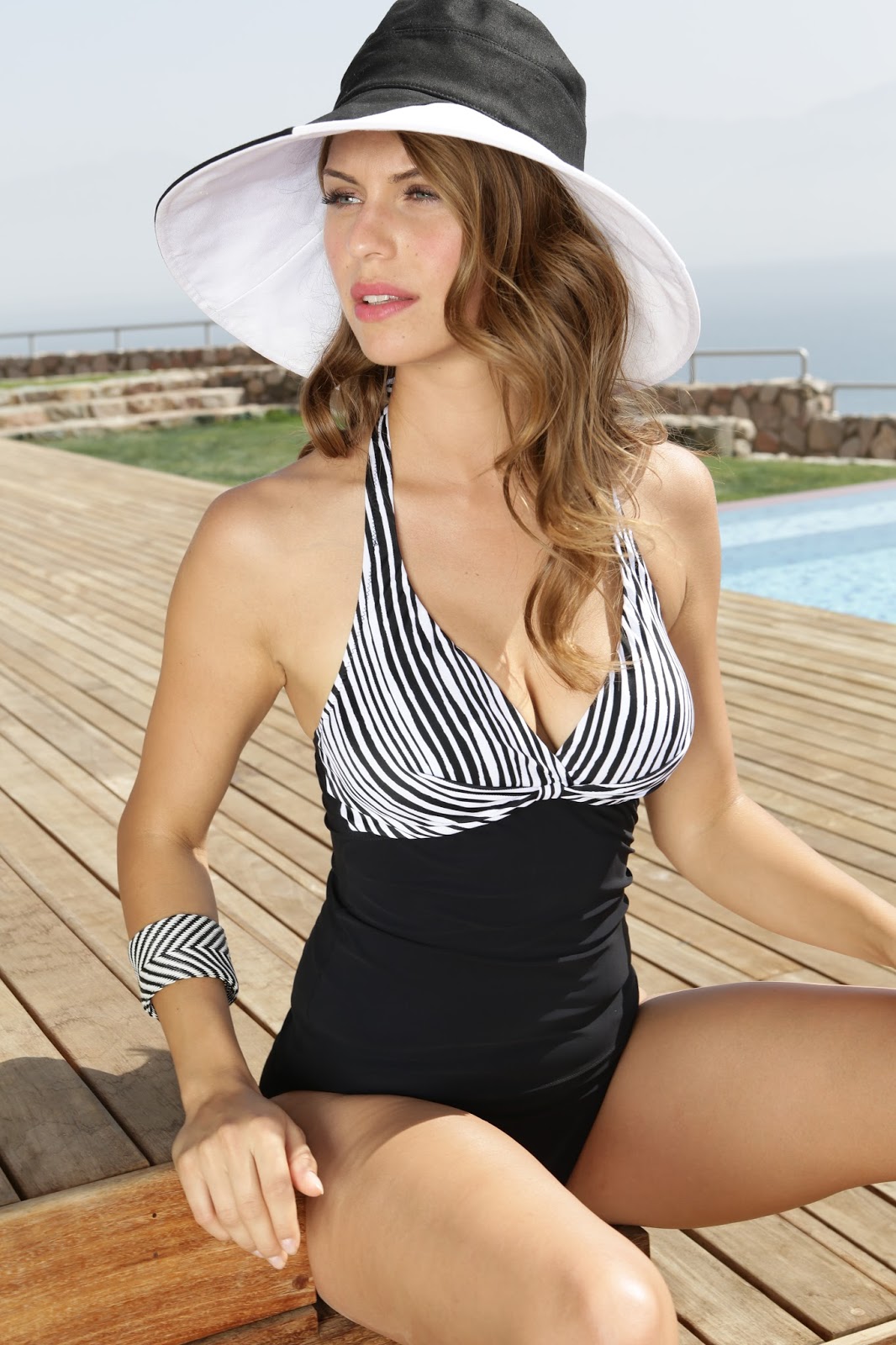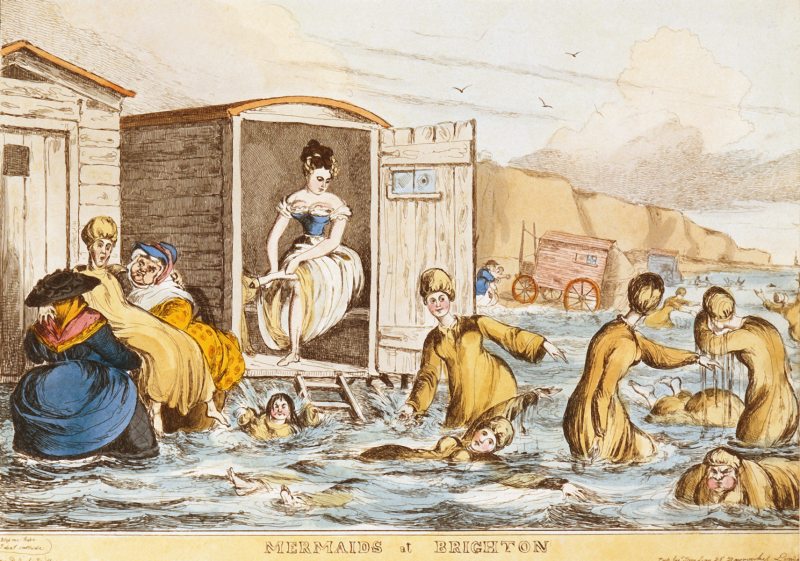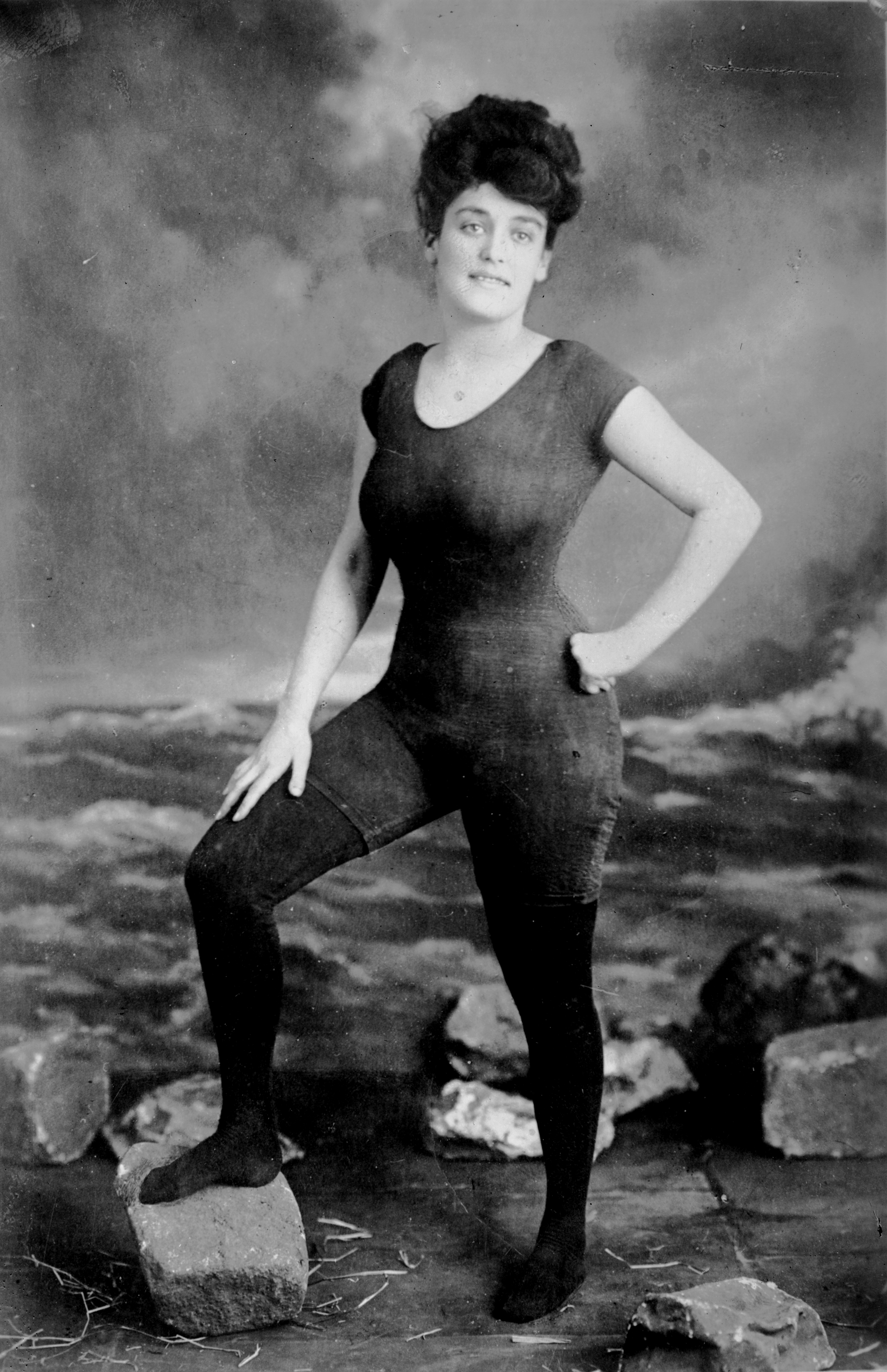Aah, the swimsuit. The
brightly-colored, body-hugging, high-tech miracle we know today is vastly
different from its ancestors; in fact, it bears absolutely no resemblance. Influenced by technology, fashion, and standards
of morality, swimsuits have evolved drastically over the last 200 years. Let’s take a little walk through swimwear’s
history.
Swimwear in Victorian Times
In the 1800’s, modesty dominated. The Victorian era was in full swing, with its
intense emphasis on moral values. Body
parts could scarcely be discussed, much less displayed. As with all the fashions of the day, bathing
attire had to cover a lot of skin and
hide the body from view. Though men and
women were often segregated in bathing or swimming settings, women still went
to great lengths to keep their form concealed from other women.
The Victorian lady would don a long swimming dress, with full-coverage
sleeves and a discreet neckline, along with bloomer-style pants
underneath. To keep the skirt from
floating upwards, the hemline sometimes included weights. The garments were made of wool, and were often
black or darkly colored. Topping off the
look were dark stockings, bathing shoes, and perhaps a hat. Let’s pause to consider how the early
Victorian woman must have felt during a trip to the beach. She’s wearing more clothing than most of us
ever wear (even in cold weather), it’s long, billowy, weighted, and made of
wool. After frolicking (if even possible) on the beach,
she goes for a quick dip in the sea, where her voluminous layers of wool get
drenched. It sounds dreadfully
uncomfortable, and extremely impractical, but at least nobody got a peak at her
knee. As the 19th century
progressed, so did women’s swimwear, albeit slowly. Sleeve lengths got shorter, as did hemlines (ankles
were spotted!).
Another modesty-inspired solution employed at Victorian era beach
resorts was the bathing machine. Not so
much a machine as a cabana-on-wheels, the bathing machine acted as a moving
dressing room. The beach-going lady
would enter the hut in her regular clothing, then once inside change into her
bathing costume. A horse would pull the
little dressing room right into the sea, where the lady could discreetly get
into the water while being shielded from prying eyes on the beach.
Turn of the Century Swimwear Innovations
With the dawn of the 20th century, swimwear continued
its slow change; capped sleeves or sleeveless gained some grounds. The skirts were shorter, and not as full, and
the bloomers reached daring mid-calf lengths.
Until this time, men had been accepted as athletic swimmers, but not
women. Around the turn of the century,
this changed, and women began to be acknowledged as legitimate in the sport of
swimming. We can assume that nobody was
winning races while
wearing a full dress and pantaloons, and so the swimsuit
began undergoing a major evolution.
In
the first decade of the 1900’s, a professional swimmer named Annette Kellerman
created a stir by designing and wearing a one piece bathing suit. Similar to a unitard, this new style was
form-fitting, hitting the legs mid-thigh, and with very short sleeves. Though she wore it with stockings, it was
still considered indecent and she was arrested.
Kellerman successfully defended her bathing suit’s design as necessary
to enjoying swimming as exercise, and went on to create a line of
swimwear.
After this milestone, swimwear continued to shrink and
change. One-piece, thigh-length suits became
more accepted, and became more colorful and form-fitting as the years marched
on. In the 1920’s, knit fabrics were
first used for swimwear. Though still
made of wool, the stretchiness of the knit fabric was ideal for the new
figure-hugging trends. The next big
change came in the 1930’s when designer Mabs of Hollywood introduced a new
fabric called lastex to swimwear. The
lastex fabric must have been a welcome change, as it was stretchy, silky, and,
well, not wool. It caught the attention
of Hollywood starlets, and swimwear veered into glamour-land. Contour-hugging suits were now the norm, and
swimwear continued getting smaller. Two
piece swimsuits started appearing in the 1940’s, though at this point they
didn’t bare much more skin than their one-piece counterparts, as the navel was
still covered.
The Bikini Explosion: the 40's and 50's
In 1947, the Bikini’s introduction produced the intended
reaction of a bomb being dropped.
Consisting of very little fabric, the new skimpy two-piece bathing suits
scandalized the world as beaches attempted to ban their use. After a few years, however, the bikini
started to make appearances, as bold starlets wore them
in public places. In 1960, “Itsy Bitsy
Teenie Weenie Yellow Polka Dot Bikini”, sung by Bryan Hyland, soared to the top
of the charts in the United States, along with the bikini’s popularity.
Around this same time, Israeli based luxury swimwear company
Gottex came onto the scene. Company
founder Lea Gottlieb had a mission to make beautiful suits that would truly
work for women. What a contrast to the
Victorian approach of covering every inch of the body in several layers! Instead, Gottex has been at the forefront of
technology in the swimwear industry, aiming to support and enhance a woman’s
body. It was one of the first companies
to incorporate a hard-cup bra into a bathing suit, and the first to use Spandex. Gottex is as strong as ever today, designing
high quality swimsuits in beautiful fabrics, as well as a large collection of
coordinating pieces such as caftans, cover-ups, scarves
and sun hats.
Since the 1960’s, swimwear has changed along with fashion,
featuring colors, patterns and cuts that reflected the broader trends. Always popular, the one-piece bathing suit
has held its place as swimwear’s go-to style.
Not to be outshone, the two-piece has maintained its place in swimwear
with developments such as the thong in the 1980’s, and (on the opposite end of
the coverage spectrum) the tankini in the 1990’s. In recent decades, “shapewear” and swimwear
have merged, using high-tech fabrics and clever designs to hide bumps and
smooth lumps.
Another recent trend in swimwear has been spurred by the increase
in information about the potential skin damage that can result from spending
time in the sun. Specially treated fabrics
provide UPF protection from UVA and UVB rays.
Rash
guards and swim shirts provide more coverage, shielding the shoulders, neck
and arms as well as the torso from the sun.
Originally, rash guards were developed for surfers, they then gained in
popularity,
seeing widespread use by children and adults alike. Swim shirts were the next development; the
rash guard’s looser cousin.
 |
Swimsuit and Coco Loco sun hat
by Profile by Gottex |
From the abundant tiers of fabric that the
Victorians swam in, to the mere inches of fabric in a teeny weeny bikini, we’ve
reached a time when it seems there’s something to “suit” everyone. Trendy bikinis abound for the body-con
fashionista, and one-piece bathing suits in figure-flattering styles and
beautiful fabrics are bountiful. For the
sun conscious, swim
shirts and rash guards provide excellent coverage, and those seeking to
supplement their look with sun
hats, cover-ups and accessories have plentiful options.
With such dramatic changes in the last two
centuries, it’s fun to ponder: what will the future of swimwear will hold?
Sources: Vintage Fashion Guild, Victoriana Magazine, Australia.gov, Fashion Maniac, Los Angeles Times













